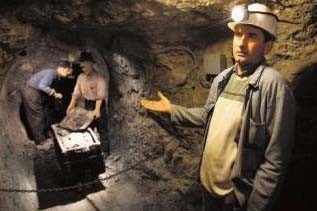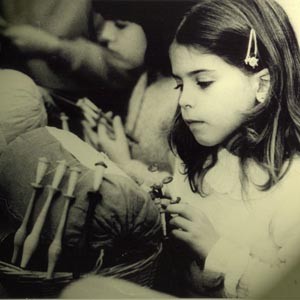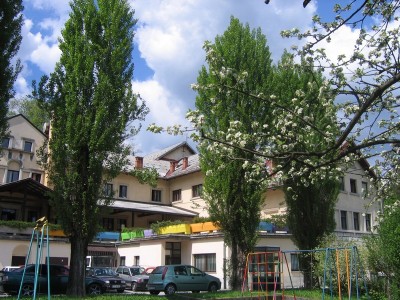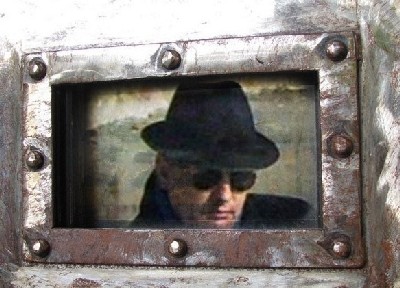_51F2A.jpg) I’ve always known that city lights attract crowds of people… as moths flying toward the light… but still, or because of that, I prefer the smaller towns. Slovenian towns especially have a unique attribute – they give a stronger feeling of visiting a city, than the bigger Slovenian cities do.
I’ve always known that city lights attract crowds of people… as moths flying toward the light… but still, or because of that, I prefer the smaller towns. Slovenian towns especially have a unique attribute – they give a stronger feeling of visiting a city, than the bigger Slovenian cities do.
Let me explain. In such small towns you feel the continuity of Slovenian identity. This is probably due to the fact that larger Slovenian cities were in the past inhabited by foreign higher classes, which left the cities after the first world war, and also due to the fact that people from rural areas started moving in large numbers to cities, once the last wave of industrialization came about (after the second world war). Hence the not too established identity of a city was lost to the massive increase of the populous.
There was no such tremendous pressure of people moving into smaller towns that were mostly settled by Slovenian population to begin with. That is why we can call these small towns the pillars of Slovenian identity and culture.
I currently live in such a town – Ljutomer – and am therefore so the more pleasantly surprised, when I see the same qualities in other Slovenian small towns – and one such town is Idrija.
_6CF1A.jpg) Naturally I’ve heard of Idrija before. I doubt there is a Slovenian, that hasn’t heard of “the lace from Idrija” or their “žlikrof” – and off course the mercury (quicksilver) mine!
Naturally I’ve heard of Idrija before. I doubt there is a Slovenian, that hasn’t heard of “the lace from Idrija” or their “žlikrof” – and off course the mercury (quicksilver) mine!
But it was only when I visited Idrija and felt the essence of this town. It is not a big city (which Slovenia basically doesn’t even have – for the entire population of a country is barely enough for a single metropolis), but you still get a feeling as though you really did come to one. It’s a feeling that has eluded me in major cities in Slovenia (such as Ljubljana, Maribor or Celje).
You can feel it in the architecture and the way buildings fit together. The main square is not mighty, but it gives off a feeling that it really stands monumentally where important things have happened in the past of the town. Things that made a difference between the city life, from the life of a rural village.
Naturally, as soon as I arrived, I wanted to try their famous žlikrof’s (especially since it was lunch time already). I always liked various types of pasta and was looking forward to trying the real Idrijski žlikrof – but have to admit I was slightly disappointed. It’s not that they were bad, far from it, but still I decided to find a pizzeria for my next meal here. I guess there’s no account for taste.
But the visit to the quicksilver mine was therefore so much more exciting then I had expected.
 Entering the Anton’s shaft I immediately thought of a Silver mine I’ve visited in Poland a few years ago. The walls were cut and reinforced into the bedrock in a very similar manner. But when I saw the chapel of the holy Trinity I admit I was in awe.
Entering the Anton’s shaft I immediately thought of a Silver mine I’ve visited in Poland a few years ago. The walls were cut and reinforced into the bedrock in a very similar manner. But when I saw the chapel of the holy Trinity I admit I was in awe.
I’m not a religious man, not belonging to any religious community or sect, yet the men who put so much hard work and effort into creating this holy structure definitely deserved my respect.
The work in the mine itself was not significantly different from the work in other mines, except that unlike in coal mines (like the one in Velenje), where there was a danger of gases, the miner here were able to smoke during work, which might not have helped their lungs any, but it sure was a morale booster.
Personally I’ve only seen mercury in old thermometers, like the one my mother made me keep under my arm pit, if I was feeling down in the dumps, and had no idea, what the ore looked like. Even though I’ve been to the mine, I guess I still couldn’t clearly identify the ore, were I to find it, but then again, the chances of me finding it in nature if even smaller then the possibility of me identifying it as such.
_72BB1.jpg) And finally I just had to, after leaving the mine, try to find the real lace from Idrija. It’s not that my special one would be a fan of lace… and I only like to see lace on her, and I’m not sure how much that is because of my lace appreciation… still I just had to buy something as a souvenir, and I’m guessing her mother would quite like it.
And finally I just had to, after leaving the mine, try to find the real lace from Idrija. It’s not that my special one would be a fan of lace… and I only like to see lace on her, and I’m not sure how much that is because of my lace appreciation… still I just had to buy something as a souvenir, and I’m guessing her mother would quite like it.
But standing there, looking at all the different products I could choose from, I could not help to wonder, about the women making them in the past. Were they like Penelope waiting for her Odysseus, to come from a hard day’s labor, biting through  the dirt and bedrock at the mine? There was something quite symbolic in every single one of those lace. It was the fate of the women, making the lace to maybe earn an extra coin, but most of all, to make a symbol of their love and devotion they had toward their men. And since then my view of the lace has changed. For if a loving wife made a lace, for her husband, to take and have something white with him while working underground, I can begin to see why there is so much care in the ornamentary details of a lace.
the dirt and bedrock at the mine? There was something quite symbolic in every single one of those lace. It was the fate of the women, making the lace to maybe earn an extra coin, but most of all, to make a symbol of their love and devotion they had toward their men. And since then my view of the lace has changed. For if a loving wife made a lace, for her husband, to take and have something white with him while working underground, I can begin to see why there is so much care in the ornamentary details of a lace.
It was getting quite late by this time, so I decided to head toward home, for Slovenia really is small enough that you can make nice daily car trips all over the country. But were I to stay and explore the town and its surroundings some more, I’d be easily convinced to spend a night at the Youth Hostlu, that is kindly inviting you to have a rest in Idrija.
 Youth Hostel DD Idrija
Youth Hostel DD Idrija 